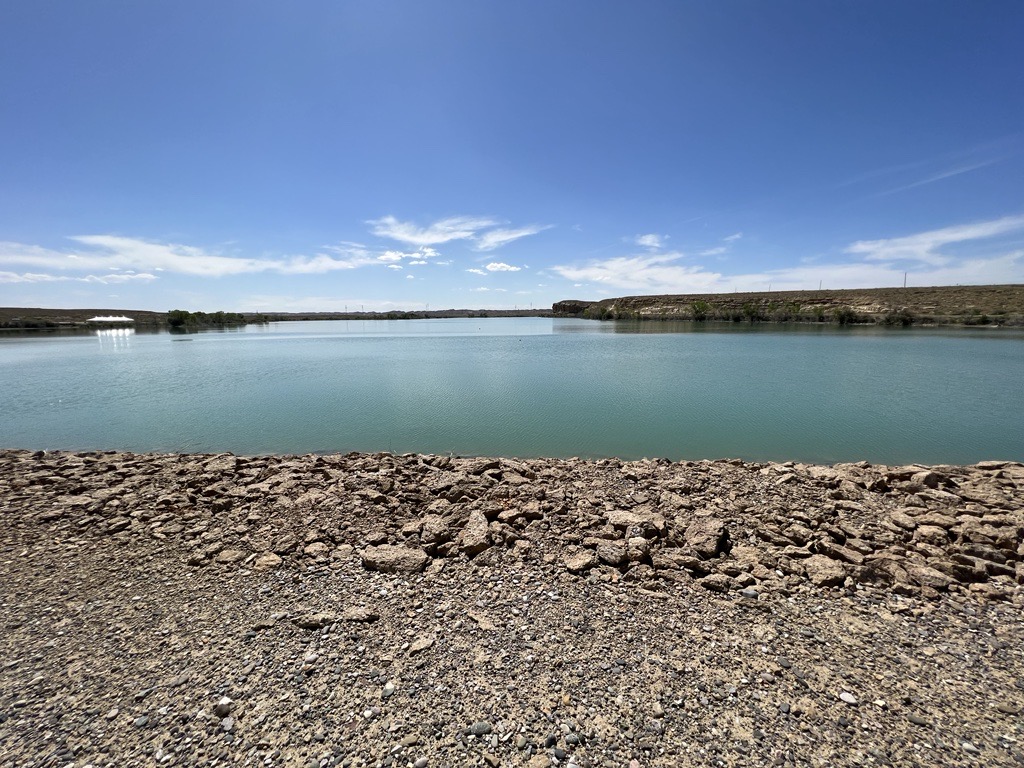 Frank Chee Willetto Reservoir
Frank Chee Willetto Reservoir
FARMINGTON, NM – Almost one year ago, the Bureau of Reclamation and Navajo Nation celebrated the acquisition of the San Juan Generating Station water conveyance system and Frank Chee Willetto Reservoir for the Navajo-Gallup Water Supply Project. This acquisition is part of Reclamation’s commitment to provide clean, safe drinking water to Tribal and rural communities.
Throughout the year, Reclamation has continued to advance designs for the reservoir and supporting facilities that will optimize and protect the water supply and ensure it is well within regulatory water quality standards.
“The Navajo Nation through the Navajo Department of Water Resources has taken numerous positions before and after the Gold King Mine Spill to have the project planned, designed and constructed to deliver a safe and reliable water supply for current and future residents on the Navajo Nation,” said Navajo Department of Water Resources Director Jason John. “Most recently, the Navajo Nation has advocated for and supported the acquisition of the Frank Chee Willetto Reservoir, knowing that it would delay the completion of the San Juan Lateral, to help ensure a better water supply and some protections of water quality for the project.”
Water from the San Juan River near Waterflow, New Mexico, will be pumped to fill the reservoir, which will then be conveyed to and treated at the San Juan Lateral Water Treatment Plant in accordance with federal, Navajo Nation, and state Safe Drinking Water Act standards. The clean drinking water will then be pumped through the project’s San Juan Lateral pipelines running south to Navajo Nation and City of Gallup communities.
“The Navajo Department of Water Resources will continue to work with Reclamation and other project partners to ensure that the project features are investigated, planned, designed and constructed in a reliable and safe manner for future use by our Navajo communities,” said John.
In preparation for acquiring the reservoir, Reclamation worked with the U.S. Geological Survey to perform surface water quality analysis and groundwater coring operations at the reservoir and nearby arroyos for over four years to ensure the reservoir's water would be safe for consumption. This not only included sampling of the water and sediments in the bottom of the reservoir, but also the surrounding soils to ensure no contaminant leakage from the nearby power plant had absorbed into the reservoir. The result from this rigorous sampling and testing revealed no major concerns about the water quality of the San Juan River or the Frank Chee Willetto Reservoir and a high level of confidence that the powerplant had no lasting impact on the reservoir and water quality.
“Reclamation’s investigations have confirmed that the Frank Chee Willetto Reservoir is not only in good structural condition, but also of better water quality than the river with low levels of heavy metals easily treated to regulatory standards by the water treatment plant,” said Reclamation’s Four Corners Construction Office Construction Engineer and Manager Bart Deming. “It will be an excellent source of drinking water for the Navajo and City of Gallup communities.”
The concentration of regulated contaminants, including heavy metals, in the reservoir from the river and nearby power plant were determined to be of no major concern and treatable to Safe Drinking Water Act standards at the San Juan Lateral Water Treatment Plant. The majority of the heavy metals detected are naturally occurring and in solid form that will settle out prior to treatment or be easily removed by water treatment. Primary regulated metals in dissolved form, which are more difficult to treat, all meet drinking water standards. Other potential contamination threats to the reservoir, such as active and abandoned oil and gas wells, were also researched by Reclamation and were deemed as very low risk to the reservoir and its water quality.
In addition to confirming that the Frank Chee Willetto Reservoir is a clean source of drinking water and was not contaminated by the 50-plus years of nearby power plant operations, the results also confirmed that the reservoir provides the benefit of allowing for settling out particles in the water, which provides an improved and more consistent water quality source compared to the San Juan River.
“The safety of our water users is our top priority,” said Deming. “We have the utmost confidence in the source water quality and the planned water treatment process on the Navajo-Gallup Water Supply Project.”
Reclamation will continue to monitor elements that are regulated under primary and secondary drinking water standards, especially if found at elevated concentrations.
"The City of Gallup understands the value of water in the southwest and is working with others to provide safe, reliable drinking water for generations to come," said Interim City of Gallup Manager JM DeYoung.
The Navajo-Gallup Water Supply Project has been in construction for over a decade to provide a long-term sustainable water supply to Navajo communities and the City of Gallup. When complete, this vital project will divert water from the San Juan River Basin, to be treated through water treatment plants on both the San Juan Lateral and Cutter Lateral and delivered through approximately 300 miles of pipeline, 19 pumping plants, and several storage tanks.
The Cutter Lateral was completed in 2021 and has been delivering clean and reliable drinking water to over 6,000 people in the eight Navajo chapters on the eastern side of the Navajo reservation and soon to the southwestern portion of the Jicarilla Apache Nation. The San Juan Lateral is over 60% complete with construction planned to wrap up in 2028 with initial water deliveries to Navajo communities in western New Mexico, the Window Rock area in Arizona, and later that year to the City of Gallup.
For more information on the Navajo-Gallup Water Supply Project, as well as for more information summarizing Reclamation’s efforts to ensure safe water for the NGWSP water users, visit: https://www.usbr.gov/uc/progact/navajo-gallup/pdf/newsletter/20240200-Navajo-GallupProjectNewsletter-Feb2024-508-UCRO.pdf


